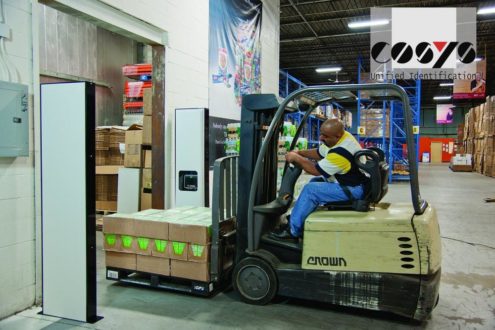
Waste in the supply chain – rethought
Everything was good and efficient – until the pandemic came
The industry follows this example. Stocks have been reduced: This ensures a lower capital commitment. The delivery takes place just in time: The truck replaces the warehouse on site. This concept of the global streamlined supply chain was a key driver of ever greater efficiency, for example in the automotive industry – until the pandemic came.
The closure of ports and factories in China has shown for the first time how vulnerable globally networked supply chains are. If a container, for example from Hongkong to Hamburg, no longer reliably takes 25 to 30 days, but twice as long, or if the container is not even cleared in China, the supply chain is stretched to the breaking point – even though, or precisely because, it has previously been trimmed to avoid waste. If the passage not only takes much longer but is also significantly more expensive, the cost benefits of "offshoring" may be gone and the waste is big because, for example, cars or machines with missing parts cannot be completed or delivered.
New playing rules for the supply chain…
This is just one of many supply chain issues, that currently affect the entire economy. Others are semiconductor shortages, shortages of paper and cardboard (for packaging), shortages of wood (for pallets), and shortages of electronic products such as switchgear and sensors.
For these materials and supply parts, new "playing rules" apply to the organization of the supply chain. Even companies with very high procurement volumes and optimally organized supply chains – especially in the automotive industry – suddenly found themselves in the unusual position that delivery failures not only occurred in the short term but for structural reasons are also to be expected in the longer term.
… and new aspects of waste
From this perspective, procurers and logisticians must now redefine the term "waste". Some factors that have been in focus so far – for example, the FIFO principle for products that have a best-before date or are otherwise subject to aging – are still important. But there are now additional, at least equally far-reaching aspects to making the supply chain work with a minimum of waste. Ultimately, it comes down to the question: Do one have to structure the supply chain in a fundamentally different way to remain capable of delivering and producing over the long term and have to consciously accept a certain amount of waste in the process?
Sustainability and social standards become more important
Also, the aspect of sustainability is playing an increasingly important role in the supply chain design, regardless of current supply chain issues. Alone due to the CO2 footprint, global transportation does not fare as well. The same applies to another factor that has found its way into the German legislation with the Supply Chain Act, which will apply from January 2023: the social standards.
Challenge: Higher dynamics
Optimizing the supply chain and eliminating waste under the new "playing rules" and circumstances is a real challenge. It requires strategic thinking: Should one – quite contrary to the best practice – deliberately accept "waste" and increase inventories? Should one shorten supply chains and rely more on regional suppliers? Equally, however, detailed work is necessary: For each individual product, where are there supply chain hazards that lead to waste, for example, production stoppages, delivery delays, penalties…?
Transparency is required
In order to be able to assess this validly, transparency is needed in the supply chain management, among other things through current data. With the right SCM software, which is also used correctly, users can systematically overview their inventories and make forecasts about the quantities to be purchased.
So far, the focus has been on further reducing inventories to avoid waste. Today, the opposite way of acting may be the better one: If supplier parts become scarce and international trade routes unreliable, safety stocks should rather be increased. Setting up secondary suppliers (who may be regionally based and more expensive because of wage costs) can also increase the delivery reliability and be less expensive after all. Because hardly anything is more "wasteful" than a stalled production or a lack of delivery capability towards the customers.
Stable supply chains with a minimum of waste
What is the best way to achieve the goal of organizing the supply chain in a more stable way (while accepting as little waste as possible)? From the perspective of ifm’s supply chain experts, three strategies in particular are effective.
Thinking ahead: best possible sales planning
The cornerstone of a functioning supply chain lies in precise demand planning. This requires a software solution that enables a detailed and reliable forecast, taking into account aspects and information from various sources, such as marketing, sales and customer planning. The demand planning module from ifm can be mentioned here in particular, which also has a wide range of applicable forecasting methods. Empirical evidence shows that this is a key to success, namely to results that are as precise as possible. Graphical representations make it easy for the user to choose the best possible method and identify outliers at a glance.
Combine purchase requisitions useful
Many companies work with alternative and second suppliers – alone due to the price comparison and dependency. This offers the opportunity to commission particularly reliable suppliers with additional vendor parts or materials. With regard to the utilization of charge carriers and to reduce transport costs, a useful bundling of purchase requisitions can also be considered. To avoid ordering too much too soon, GIB Buying from ifm provides suggestions that can be transferred to the system with a click. This makes it easy to weigh up costs against the risk of failure. And quite incidentally, CO2 emissions are also reduced.
Plan the production sequence neatly
Optimized production sequence planning across all orders, taking into account all workstations in the plant as well as all relevant restrictions, also helps to circumvent bottlenecks caused by a lack of parts/material availability. With the pegging module, which most people previously only knew from SAP APO, and a new optimization algorithm from ifm, capacities, time stamps, targets, bottleneck factors and material availabilities flow into the calculation. An optimized detailed production plan is then ejected that is actually feasible and takes all selected orders into account. This is how production planning works, even in difficult times.
By: Gerald Scheffels for ifm
As licensed SAP Silver Partner and expert for efficiency and transparency in the supply chain, ifm’s software division offers i. a. holistic software solutions that are fully integrated in the SAP system. Internationally, ifm has been known as an automation specialist for decades. Since 2016, the digitization of all business processes and their integration into the SAP/ERP system has also become an important business area of the ifm group.
With "GIB SCX", logistical processes are optimized from demand to production planning up to procurement and inventory management. This makes supply chain processes faster, more transparent and more efficient. The out-of-the-box supply chain solutions run on SAP ECC 6.0 and SAP S/4HANA and are available both on-premises and in the cloud. They help identify and eliminate overstocks, reduce process costs, and increase liquidity by releasing tied-up capital. The IIoT tool "GIB Shop Floor Integration" enables the connection of the production level and thus guarantees continuous communication from the sensor to the SAP.
ifm’s SCM solutions are scalable up and down. In this way, both complex corporate requirements and the budget specifications of medium-sized companies are met. More than 900 customers worldwide already rely on ifm’s supply chain solutions and thus benefit from sustainable inventory optimization while increasing delivery readiness.
ifm electronic gmbh
Martinshardt 19
57074 Siegen
Telefon: +49 (271) 23871-4000
Telefax: +49 (271) 23871-4999
http://www.ifm-business-solutions.com
Produktmanagement Marketing/Projekte
Telefon: 0271 238 714152
E-Mail: ariane.becker@ifm.com
Produktmanagement Marketing/Projekte
Telefon: 0271 238 714141
E-Mail: lena.schneider@ifm.com
![]()




